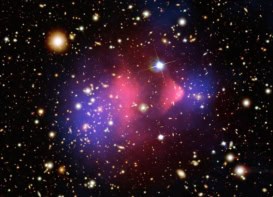
A recent astronomical observation that the ordinary matter in the early universe was much cooler than expected could be explained if a small proportion of dark matter has a tiny electric charge. That is the claim of Julian Muñoz and Abraham Loeb at Harvard University in the US, who say that further evidence to confirm or refute their hypothesis should be forthcoming in the next few years. However, some astrophysicists remain sceptical of the original observation itself.
Although dark matter has yet to be detected directly, its existence is the leading explanation for why large-scale structures such as galaxies appear to contain much more mass than can be seen using telescopes. Attempts to detect electric charges in dark matter have always drawn a blank, so astrophysicists have assumed it to be completely neutral: “We know from our galaxy and nearby galaxies that dark matter is fairly cold and collisionless,” says Muñoz, “which means that it shouldn’t have a charge because things with charges collide and interact.”
Recently, astronomers used the EDGES radio telescope in Australia to observe radiation emitted just 180 million years after the Big Bang — when the first stars ignited. At this cosmic dawn, astrophysicists expect that interstellar hydrogen gas would be cooler than cosmic background radiation. This is because stars and stellar remnants would have yet to reheat the gas. Cool gas can absorb cosmic background radiation at 21 cm wavelength, which corresponds to an atomic spin transition in hydrogen. The EDGES team observed an absorption signal – redshifted by the expanding universe to several metres’ wavelength – that was much stronger than expected. This suggested that the gas was much cooler than predicted by astrophysical models.
New force?
In a theoretical paper published earlier this year in Nature alongside the EDGES results, astrophysicist Rennan Barkana of Tel Aviv University in Israel offered an explanation. He proposed a hypothetical interaction between normal matter and dark matter, with dark matter assumed to be the colder of the two. If normal and dark matter could interact and exchange energy, the normal matter would cool down and absorb more energy from the cosmic microwave background. “We argue the Barkana paper required a new force entirely between the dark matter and [normal matter],” says Julian Muñoz. However, such a force should also act between particles of normal matter, and there is no evidence of this.

Ancient hydrogen reveals clues to dark matter’s identity
In a new paper published in Nature, Muñoz and Loeb argue the data could be explained more naturally if a small proportion of dark matter carries a tiny fractional electric charge. This charge could be too weak for direct detection by any previous experiments: “We mean maybe a million times smaller than that of the electron,” says Muñoz. Moreover, if the vast majority of dark matter were neutral, the effects on galactic dynamics would not be visible today. At the cosmic dawn, however, the density of the universe would be much higher than today and the temperature of the gas would be lower – making the particles slower moving. Any electromagnetic interaction between dark matter and normal matter would therefore be much stronger.
Muñoz and Loeb are now looking to astronomers using several other telescopes in attempts to replicate the EDGES observations. In the future, the HERA radio telescope in South Africa is planning to observe fluctuations in the 21 cm absorption line at progressively higher redshifts (further back in time). If the researchers are correct, says Muñoz, then, at redshifts near the cosmic dawn, HERA should detect stronger absorption signals where there is thought to be more dark matter, as the hydrogen gas should have been cooled further in these regions of the sky.
More data needed
Alan Rogers of Massachusetts Institute of Technology – a member of the EDGES collaboration – cautions that there are other potential explanations for the signal, such as a hotter cosmic background at the time: “My main motivation at this point is getting more data from the field and helping other groups with similar experiments,” he says. “EDGES is the only data we have right now that’s showing this: that situation obviously has to change before what we’ve seen is going to be taken as definitive.”
David Spergel of Princeton University agrees. He is sceptical, however, that the EDGES experiment will survive replication, noting that the foreground noise in the experiment was “about ten-thousand times brighter than the signal”. “I think one measure of [the Muñoz and Loeb] paper is that it shows – if the EDGES result was correct – how complex a model would be needed to fit the data,” he says. “That would make the discovery more important because we would learn a tremendous amount about the properties of dark matter. On the other hand, the requirement on what you’d need in terms of new physics is pretty demanding. I think for many of us this makes it even less likely the experimental result will be confirmed by future data. Though the nice thing about science is: we get more data; we learn which measurements are correct and which ones aren’t!”



